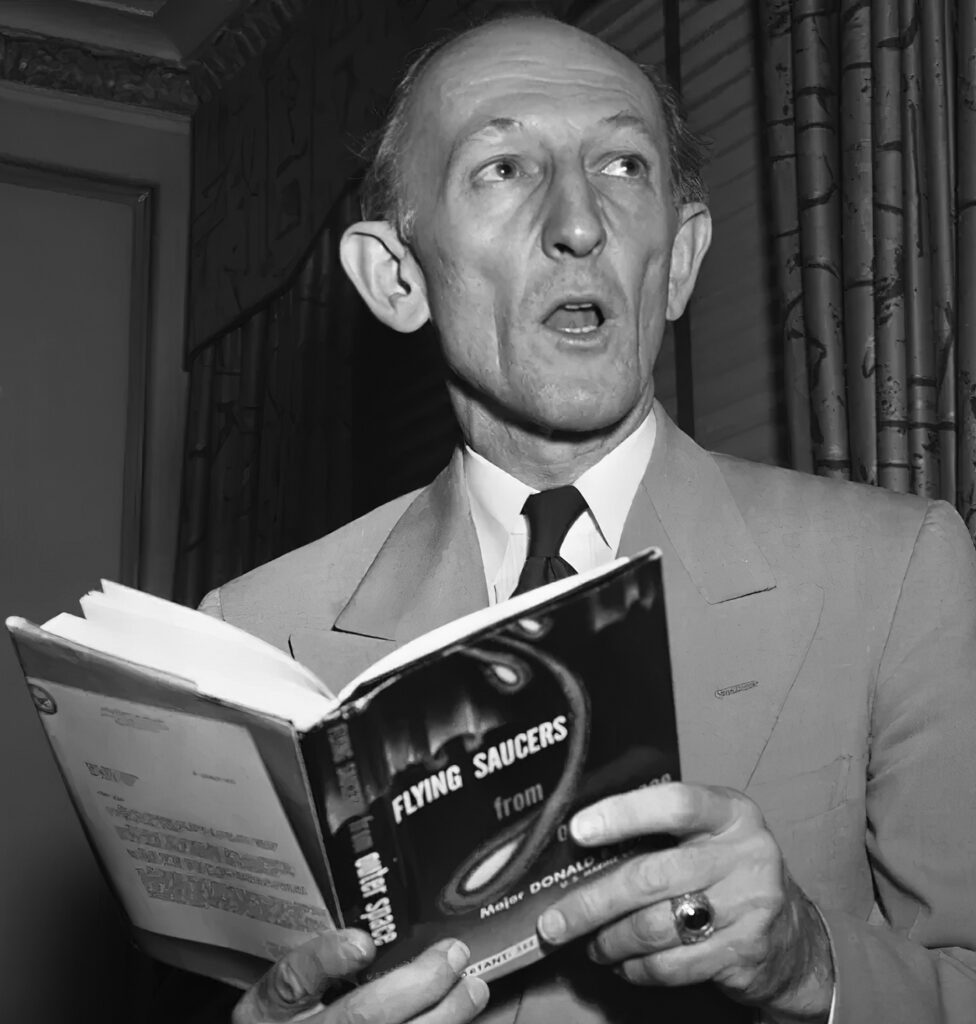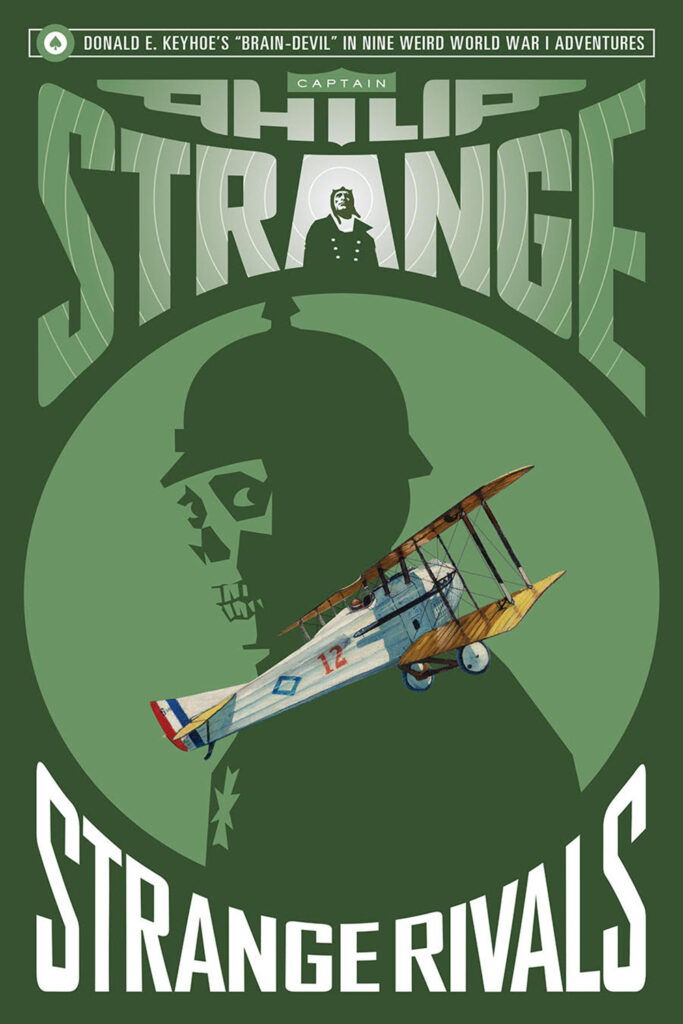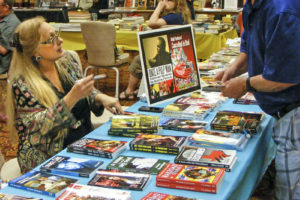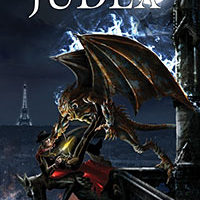Donald Keyhoe (1897-1988) is someone who is known for several things. For most of us, he is probably best known as a pulp writer of many aviation heroes and other works, which makes sense as he was a pilot with the U.S. Marines. But he is also known as a UFO researcher, having written one of the earliest books on UFOs, Flying Saucers Are Real (1950), which lead him into a new phase of his life through the 1950s and ’60s, after he founded NICAP, a UFO research group.

But as this blog is about pulp and pulp fiction, we will instead focus on his pulp writing career.
Keyhoe started writing as a hobby after being injured as a Marine pilot in the early 1920s, and later retiring from the Marines due to that injury. He returned to the Marines during WWII as a flight instructor, retiring as a major.
His first writing in the pulps was a quartet of stories in Weird Tales (1925-27). I’m not aware of them being reprinted. The last two, “Through the Vortex” (July 1926) and “The Master of Doom” (May 1927), were cover featured. After this, he shifted over to the air pulps.
He was also doing other work, including flying with Lindbergh in 1927, which led to his first book, Flying With Lindbergh (1928).
But he is probably best known as the author of several series, almost all about aviators, and most have been reprinted. Interestingly, his first three all started in 1931 in different magazines from two publishers. If I haven’t yet, I will be reviewing them all. These include:
Capt. Philip Strange, his first and longest series at 64 stories 1931-39 in Flying Aces. Age of Aces has reprinted the entire series in nine volumes. Capt. Strange, also known as “the Brain Devil” and “the Phantom Ace of G.2,” was an American intelligence officer during World War I gifted with ESP and other mental powers. But in addition, his WWI was a bizarre war with strange foes, giant pterodactyls, mystic fireballs, and demon aces. Many say Strange was the inspiration for Robert J. Hogan‘s G-8, which started two years later, but Philip Strange is supposedly better written. I will be reviewing this series soon and hope to do a comparison of the two. I might do a more detailed look into the series.
 Devildog Squadron, his second series started in 1931, the same month as Philip Strange, has 24 stores from 1931-35 in Sky Birds, with the magazine only lasting one issue after the last story appeared. Age of Aces has reprinted the first volume of a planned four-volume series. This one is about a squadron of Marine pilots having strange and weird adventures during WWI.
Devildog Squadron, his second series started in 1931, the same month as Philip Strange, has 24 stores from 1931-35 in Sky Birds, with the magazine only lasting one issue after the last story appeared. Age of Aces has reprinted the first volume of a planned four-volume series. This one is about a squadron of Marine pilots having strange and weird adventures during WWI.
Jailbird Flight, his third series in 1931, started the next month after the other two. This short series had 12 stories in 1931-34, first in Battle Aces, then Battle Birds, and finally Dare-Devil Aces. Age of Aces has reprinted the whole series in two volumes. This one has a group of convict fighter pilots in daring missions during WWI.
Vanished Legion has seven stories 1932-34 in Dare-Devil Aces. Age of Aces has reprinted the entire series in one volume. This one is apparently another weird war in WWI with a group of pilots listed as “killed in action.”
Richard Knight is another long-running series at 35 stories from 1936-42 in Flying Aces, where it alternated with Philip Strange. Altus Press/Steeger Books has reprinted two volumes and more are promised. I think we’ll need six to seven more volumes. This one is set during the period it was published, with Knight, a former WWI pilot blinded in combat but able to see at night, on various weird missions that involved dinosaurs, lost races, and more.
When Popular Publications‘ Wu Fang, coincidentally written by Hogan, ended, they quickly replaced it with Dr. Yen Sin, written by Keyhoe. Sadly he only lasted three stories in 1936. Steeger Books has reprinted the series, including a deluxe edition with added articles. Keyhoe gave us the more interesting Michael Traile as the hero who could not sleep to oppose the villain.
Eric Trent was another short-lived series at 13 stories from 1940-42 in Flying Aces, kind of filling the void in Flying Aces after Philip Strange ended. Altus Press/Steeger Books has reprinted the first half in one volume, with the final volume coming soon. This one has our title hero flying around Europe as WWII starts, getting into trouble, and later shifting elsewhere in the world. Will be interesting to see how this one works out.
And for completeness, there is another very short series, all of four stories, with Al “Click” Jarnaghan in Flying Aces from 1941-42, slotting in with the others. I have no idea if this will be reprinted by someone. This one is his final series, and maybe the last of what he wrote in the pulps. Maybe Age of Aces could do this as a special PulpFest volume? Flying Aces pretty much ended almost all their fiction series in 1942. Only Joe Archibald‘s Phineas Pinkham would continue until at least November 1943.
There were a few stand-alone works as well, but these are his series. As noted, I will at some point be reading and reviewing these series if I haven’t already. Do check them out as almost all of it is now readily available from either Age of Aces or Steeger Books.



